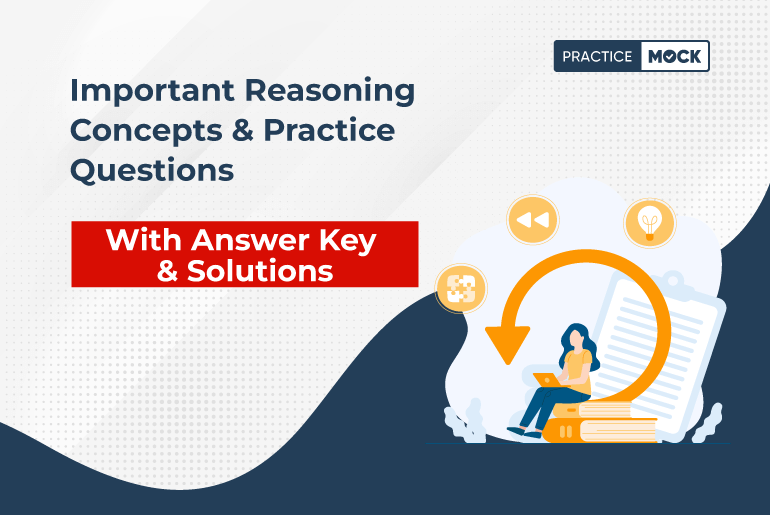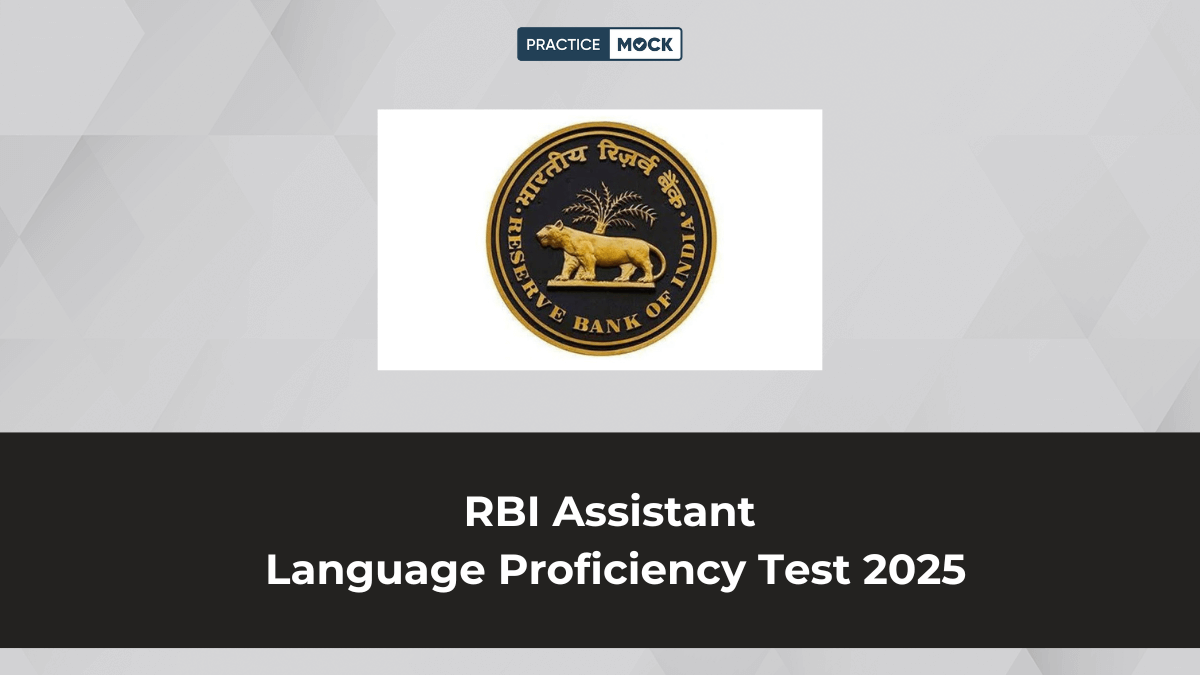Important Reasoning Concepts & Practice Questions with Answer Key & Solutions


The Reasoning section as we all know is quite an important section which many aspirants find difficult and time consuming. Those who are preparing for the upcoming banking exams must try to achieve great results in the reasoning section and for that one must study well by preparing and practicing all important topics. In this article we will be guiding the candidates with all Important Reasoning Concepts & Practice Questions with Answer Key & Solutions. The important topics will be well explained along with examples and few practice questions. For all those who find the Reasoning section difficult, the best strategy is to prepare for it thoroughly and if prepared properly, it may help you achieve the highest possible score. Below are the important reasoning concepts:
RBI Assistant Free Mock Test 2023
Important Reasoning Concepts
It is important to understand these critical concepts or topics for reasoning preparation especially for banks. Thus, it’s important for the candidates to prepare the below mentioned topics thoroughly.
- Blood Relations
- Syllogism
- Inequalities
- Ranking
- Seating Arrangement
- Puzzles
- Direction Sense
- Coding Decoding
- Miscellaneous
RBI Assistant Free Mock Test 2023
Types of Blood Relations
A few types of blood relation questions are
Dialogue or Conversation Based: In these types of questions a statement is laid by a person describing a relation. The person may or may not be personally related to the one stating it.
Coding-Decoding: It is one of the recent types of blood relation questions, usually asked in the mains exam. In these questions, relations are represented by symbols.
Based on Puzzles: The blood relations are described in the form of a puzzle. Brief information about the relation between people is provided and questions are asked on the basis of that.
Types of Syllogism
Basic Syllogism: In this type of syllogism questions, the statements are 100% true and the conclusion must be 100% true.
Example:
Statement: All Ball is Oval. Some Oval is Circle.
Conclusion: Some Ball is Circle.
The above conclusion is definitely false as we cannot derive any relationship between Ball and Circle from the above statement.
Complimentary pairs (Either – Or Case): In this type of syllogism questions, the statements are 100% true and two conclusions together can be partially true. Here are three cases when ‘Either-Or’ follows:
Some + Some not
Some + No
All + Some not
Example:
Statement: All Ball is Oval. Some Oval is Circle.
Conclusion:
Some Ball is Circle – False (As, there is no relation between Ball and Circle)
No Ball is Circle – False (As, there is no relation between Ball and Circle)
But if we consider both the conclusions together then, either conclusion 1 or conclusion 2 is true as this is a complimentary pair. If we consider the first conclusion to be true, the second conclusion is definitely false and if we consider second conclusion to be true, then the first conclusion is definitely false. So, both the conclusions together can be partially true.
Only – Only a few: This type of syllogism is conditional based syllogism. This is one of the most important concepts to be covered in syllogism as the questions based on ‘only – only a few’ is really confusing. If a statement says ‘only a few A is B’, then only a certain part of A is B and the remaining part is not B and if a statement says ‘Only A is B’, then All B is A, such that B can be only part of A.
Possibility based Syllogism: In this type of syllogism, the conclusion is based on possibilities e.g., if ‘All A is B’ and ‘No A is C’, then ‘Some C being B is a possibility’ is definitely true. In such type of syllogism, ‘can be’ or ‘possibility’ keywords are used.
Coded Syllogism: This type of syllogism usually comes in Mains examination, in which a comparison between two elements is usually defined by code i.e., symbol, number etc. For example: In, A&B, ‘&’ represents ‘some’, so we can interpret ‘Some A is B’.
Reverse Syllogism: This type of syllogism also comes in Mains examination. In this, few conclusions will be given, and you have to find out which statements given in the options will follow all these conclusions.
Read More: How to Master Syllogism Concept along with Practice Questions- Important for RBI Assistant
RBI Assistant Free Mock Test 2023
Inequalities
- P > Q means P is greater than Q.
- P < Q means P is less than Q.
- P = Q means P is equal to Q.
- P ≥ Q means P is greater than or equal to Q.
- P ≤ Q means P is less than or equal to Q.
In order to solve questions, understanding the order or the rank of these symbols is very important.
- If A > B ≥ C is given, then A > C is true and not A ≥ C as, here the greater than sign is of higher order.
- If A ≥ B is given, then either A > B or A = B is true.
- If A < B < C is given, then A < C is true.
- If A < B > C is given, then the relation between A and C cannot be determined.
RBI Assistant Free Mock Test 2023
Types of Questions asked in Inequality
To solve the questions based on inequality, the relation between the given elements is to be determined. The three patterns in which the Inequality questions in reasoning are asked is as follows:
- Basic/Normal inequality: In these types of questions, the elements are given and the relationship between them is marked with the help of the signs (<, >, =, ≥ and ≤). These types of questions are frequently asked in the preliminary exam of all major government exams.
For example: P < Q ≤ R ≥ S
- Coded Inequality: This is a new format of inequality questions. Here instead of direct symbols, each sign is coded using a symbol, a number or an alphabet.
For example, ‘A#B where ‘#’ means A is greater than or equal to B’. Here, the ‘≥’sign has been denoted with the ‘#’ sign. This pattern is being followed in particularly the mains exam of all major government exams to make the questions complex and confusing. The coded inequality questions take a bit more time than the direct inequality questions, as the codes are first to be replaced with the respective symbols. Thus, the code based inequality questions require continuous practice to improve speed.
- Missing symbol inequality: In these types of a question a statement is given with symbols missing. A relation, which needs to be satisfied, is given in the question and set of symbols which are to be placed in the blanks is given in option. These questions can both be basic or coded.
Read More: Tips to Master Inequalities Concept with Practice Questions
Recent Posts
Linear Seating Arrangement for RRB PO 2025, Check Strategy to Solve Question in 5 Min
In this article we are providing the Linear Seating Arrangement for RRB PO 2025. Candidates…
How to Crack SBI CBO 2025 Exam in 1 Month Without Coaching?
Here we are providing a detailed strategy to crack the SBI CBO 2025 Exam in…
Why Most Candidates Fail To Clear IBPS PO Exam?
Don’t repeat others’ mistakes! Learn why many fail the IBPS PO exam and how you…
SSC CGL 3 Months Study Plan 2025, Start Your Prep. With Our Free Resources
In this blog, we have provided the complete SSC CGL 3 Months Study Plan. Candidates…
RBI Grade B Eligibility Criteria 2025, Check Educational Qualification & Age Limit
RBI Grade B Eligibility Criteria 2025 covers information age limit, educational qualification, and nationality provided…
SSC CHSL Eligibility Criteria 2025: Check Age Limit, Education Qualification
This blog has provided the SSC CHSL Eligibility Criteria 2025, which includes the Age Limit,…


